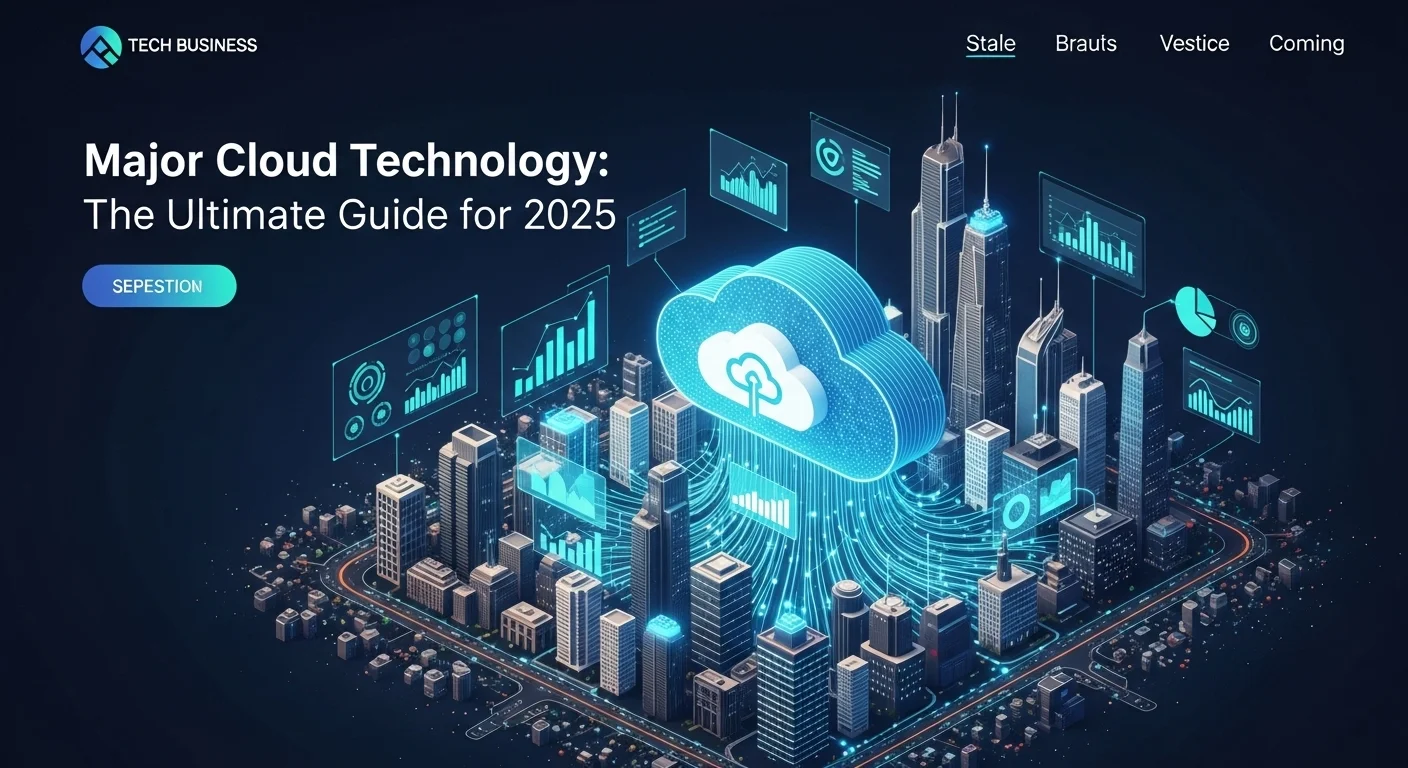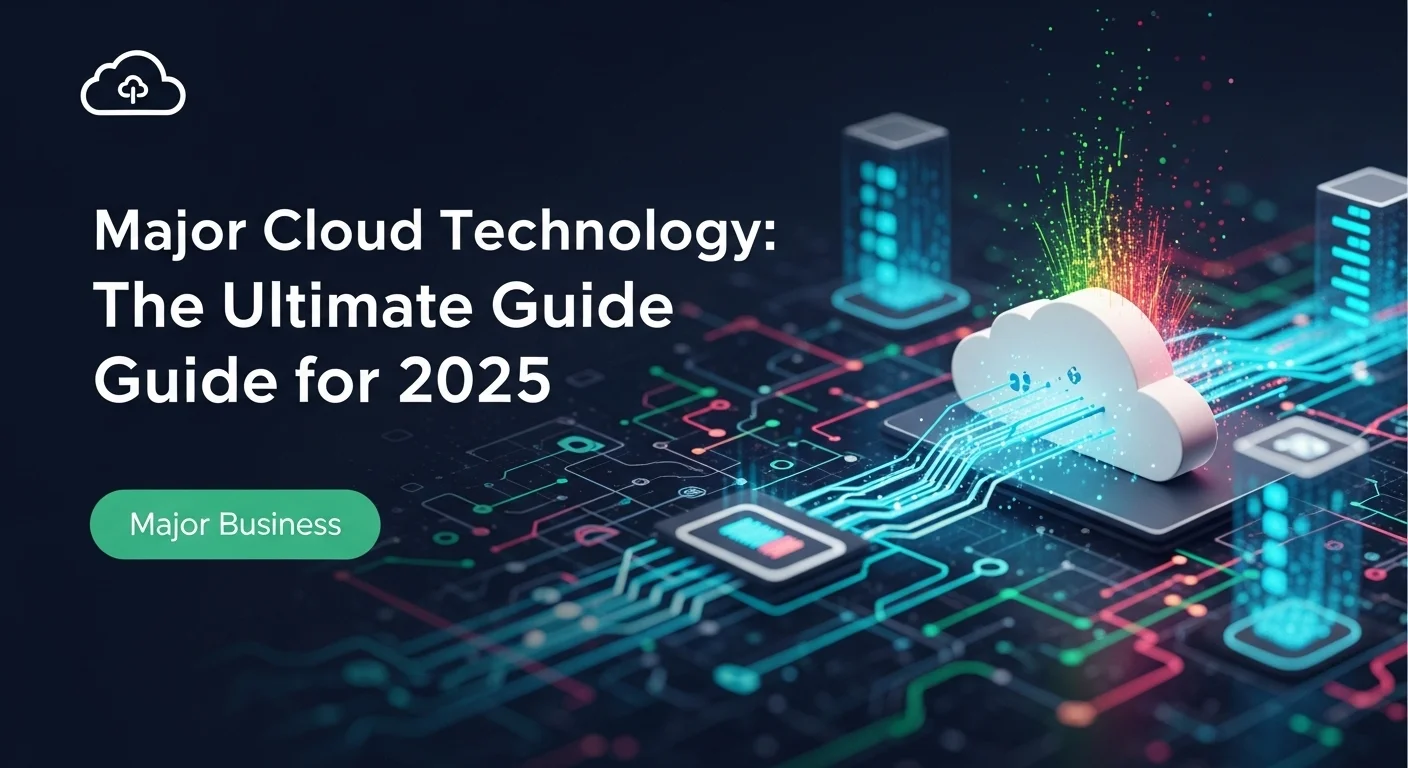Navigating the Cloud Giants: A Practical Guide to AWS, Azure, and GCP

Executive Summary
I've spent over a decade helping businesses navigate the complex world of cloud computing. In the beginning, it felt like the Wild West, but now, a few giants—AWS, Azure, and GCP—dominate the landscape. Understanding them isn't just for tech gurus anymore; it's a core business skill. In this guide, I'll cut through the jargon and share what I've learned from years in the trenches. We'll explore what makes these platforms tick, how to choose the right one for your needs (whether you're a startup or a global enterprise), and how to leverage their power to gain a real competitive edge. This isn't just a technical manual; it's a strategic roadmap to help you succeed in the cloud.
Table of Contents
Table of Contents
What is Major Cloud and why is it important in Technology?
In my years as a strategist, I've seen 'cloud computing' go from a buzzword to the absolute backbone of modern business. At its heart, the concept is simple: instead of owning your own computing infrastructure, you access it over the internet from companies that specialize in it. This gives you incredible flexibility and power. But the term 'Major Cloud' refers to something more specific: the dominant ecosystem of massive-scale platforms run by a handful of tech giants. These companies have invested billions to build a global network of data centers that power everything from your favorite streaming service to critical banking applications. For anyone in business or tech today, understanding this landscape isn't just helpful—it's essential for survival and growth.
The main players you'll hear about constantly are Amazon Web Services (AWS), Microsoft Azure, and Google Cloud Platform (GCP). While others like Oracle and IBM are in the game, these three are the titans setting the pace. When people talk about moving to a major commercial cloud platform, they're almost always talking about one of these three. They provide the foundation upon which countless modern digital experiences are built.
The Core Services: IaaS, PaaS, and SaaS Explained
To really get what these platforms offer, it helps to understand their three main service models. I've found the best way to explain it is with a pizza analogy.
- Infrastructure as a Service (IaaS): This is like being given a professional kitchen. You get the oven, the counters, the gas, and the electricity, but you have to bring your own ingredients, recipes, and know-how to make the pizza. In tech terms, you rent the fundamental building blocks—servers, storage, networking—and you build everything on top of that. It gives you the most control. The big services here are Amazon EC2, Azure Virtual Machines, and Google Compute Engine.
- Platform as a Service (PaaS): This is like getting a pizza-making kit delivered to your door. You get the dough, sauce, cheese, and toppings all ready to go. You just have to assemble it and bake it. PaaS gives you a platform to build and run your applications without worrying about the underlying infrastructure. It’s a huge time-saver for developers. Think of services like AWS Lambda or Azure App Service.
- Software as a Service (SaaS): This is simply ordering a pizza for delivery. The finished product arrives at your door, hot and ready to eat. You don't worry about the kitchen, ingredients, or cooking at all. SaaS products are the apps you use every day through your web browser, like Microsoft 365, Google Workspace, or Salesforce. They are complete solutions, often running on one of the major cloud platforms.
Why the Cloud is a Game-Changer for Modern Business
Moving to one of these leading cloud platforms isn't just a tech upgrade; it's a strategic business move. I've seen it transform companies firsthand in several key ways.
1. Smarter Spending: In the old days, you had to spend a fortune on servers upfront, often buying more than you needed just in case. The cloud flips this model. You pay only for what you use, like a utility bill. This makes costs more predictable and frees up capital for other parts of your business. The major providers have incredible tools to help you track every penny you spend.
2. Scale on Demand: One of my favorite cloud stories involves an e-commerce client. Their traffic would explode during holiday sales. In the past, this was a nightmare. On the cloud, we set their system to automatically add more server power when the rush started and scale back down when it ended. This elasticity is a superpower that allows businesses to react instantly to market demands.
3. Go Global in Minutes: The big cloud providers have data centers all over the world. This means you can launch your application in Europe or Asia just as easily as in your home country, giving your users a faster, better experience. They also build their systems to be incredibly resilient, so even if one data center has an issue, your application can keep running smoothly.
4. Innovate Faster: These platforms are more than just storage and servers. They offer powerful, off-the-shelf services for things like Artificial Intelligence (AI), data analytics, and the Internet of Things (IoT). I’ve seen small teams build incredibly sophisticated apps by leveraging these tools—things that would have required a team of PhDs and a massive budget just a decade ago. This dramatically speeds up how quickly you can bring new ideas to life.
5. Enterprise-Grade Security: While you have a role to play, the cloud giants employ armies of the world's best security experts. Their data centers have security measures that are far beyond what most individual companies could afford. They also handle a lot of the heavy lifting for complying with regulations like GDPR and HIPAA, which can be a huge relief for businesses in regulated industries.
In short, the Major Cloud has leveled the playing field. It gives any company, large or small, access to the same world-class technology. Embracing it is no longer just an option; it's the most effective path toward a more efficient, agile, and innovative future.

Complete guide to Major Cloud in Technology and Business Solutions
Once you understand the 'what' and 'why' of the cloud, the next big question is 'which one?' Choosing the right platform is a critical decision that depends on your company's unique DNA—your existing tech, your team's skills, and your future goals. Let me walk you through the big three and share some insights from my experience on how to make the right choice.
A Comparative Look at the Top Major Cloud Service Providers
The market is a three-horse race between AWS, Microsoft Azure, and Google Cloud (GCP). They all offer fantastic services, but they come from different places and have different personalities.
1. Amazon Web Services (AWS)
AWS is the original pioneer and still the market leader. They've been around the longest (since 2006) and have an unbelievably vast menu of over 200 services. They are the definition of a mature, battle-tested platform.
- My Take: I often recommend AWS to startups and digital-native companies. Why? Because you can build almost anything you can imagine on it. The community support is massive, meaning you can find an answer to almost any problem online. I worked with a fast-growing fintech startup that built its entire, highly secure platform on AWS, scaling from a handful of users to millions without a hitch. Its core services like EC2 for servers and S3 for storage are the industry standard for a reason.
- Best For: Versatility. If you need a wide array of tools and value a mature ecosystem with tons of documentation, AWS is a safe and powerful bet.
- Heads-up: The sheer number of options can feel like drinking from a firehose for newcomers. Managing costs can also get complex, so having someone who understands cloud finance (FinOps) is a must.
2. Microsoft Azure
Microsoft was a bit later to the party, but they used their enterprise dominance to catch up fast. They are the undisputed champion of the 'hybrid' world, seamlessly blending on-premises data centers with the public cloud.
- My Take: I once consulted for a large, traditional manufacturing company looking to modernize. They had decades of investment in Microsoft software—Windows Server, Office, Active Directory. For them, Azure was a no-brainer. It felt like a natural extension of their existing IT world. The integration is incredibly smooth, and their focus on enterprise-grade governance and security gives executives peace of mind.
- Best For: Large enterprises, especially those already in the Microsoft ecosystem. Its hybrid cloud capabilities with tools like Azure Arc are second to none.
- Heads-up: While its service list is huge, some of the newer, more niche services might not be as mature as their AWS equivalents.
3. Google Cloud Platform (GCP)
Google Cloud is the dark horse, powered by the same infrastructure that runs Google Search and YouTube. Their strengths lie in the areas Google is famous for: data, networking, and cutting-edge, open-source technology.
- My Take: I worked on a project for a retail company that wanted to build a world-class recommendation engine. We chose GCP. Their expertise in data analytics (with BigQuery) and AI/Machine Learning is simply phenomenal. They also pioneered Kubernetes, the standard for modern application deployment, so it’s a natural home for developers building cloud-native apps. I also find their pricing models to be very transparent and often more cost-effective for certain workloads.
- Best For: Data-heavy, cloud-native applications. If your business lives and breathes data, analytics, or machine learning, you have to look at GCP.
- Heads-up: Their service catalog isn't quite as broad as the other two, and historically, their enterprise support was seen as playing catch-up, though they are investing heavily to change that.
Technical Methods and Business Techniques for Cloud Adoption
Moving to the cloud is a journey, not a destination. From a practical standpoint, this usually involves one of the '6 R's' of migration. I've guided clients through all of them:
- Rehosting (Lift and Shift): The quickest way. You move an application as-is. Fast, but you won't get all the cloud benefits.
- Replatforming (Lift and Reshape): You make a few tweaks during the move to take better advantage of cloud features, like switching to a managed database service.
- Repurchasing (Drop and Shop): You ditch your old app and move to a SaaS product, like swapping your old email server for Microsoft 365.
- Refactoring/Re-architecting: The most intensive path. You redesign your application from the ground up to be cloud-native. It’s a lot of work but yields the biggest rewards in performance and scalability.
- Retiring: You take a hard look and realize an application is no longer needed. Shutting it down can save a surprising amount of money.
- Retaining: Sometimes, it makes sense to keep an application on-premises for regulatory or performance reasons.
Guiding Frameworks and Cost Management
The big players offer frameworks (like the AWS CAF) to guide you through this process. I highly recommend using them. They're like a comprehensive checklist that ensures you don't miss critical steps related to your people, processes, and governance.
Finally, a word on cost: FinOps (Financial Operations) is a non-negotiable skill in the cloud era. It's a practice that brings your finance and tech teams together to manage cloud spending. This involves tagging every resource to see where the money is going, constantly looking for ways to optimize (like shutting down idle servers), and forecasting future spend. Without it, your cloud bill can easily get out of control.
Ultimately, many businesses I work with end up using more than one cloud (a multi-cloud strategy) to get the best of all worlds. The key is to do your homework, understand your own needs, and choose the platform that's the best fit for you, not just the one that's most popular.

Tips and strategies for Major Cloud to improve your Technology experience
Getting your applications onto a major cloud platform is just the first step. The real magic happens when you learn how to operate there efficiently and securely. Over the years, I've seen teams make the same mistakes over and over. Here are some hard-won lessons and practical tips to help you master the cloud and avoid common pitfalls.
I. Best Practices for Cloud Excellence
Think of these as the golden rules for living happily in the cloud, no matter which provider you choose. Frameworks like the AWS or Azure Well-Architected Frameworks are built on these core pillars.
1. Security: Your Number One Job
The biggest misconception I see is that the cloud provider handles all security. That's only half the story. They secure the *of* the cloud (the physical data centers), but you are responsible for security *in* the cloud (your data and applications).
- Live by the Principle of Least Privilege: This is my mantra. Only give users and services the absolute minimum permissions they need to do their job. Never use your main 'root' account for everyday tasks. I've seen a single compromised admin account cause catastrophic damage. Audit these permissions regularly.
- Encrypt Everything: There's no excuse not to. Encrypt your data when it's sitting in storage (at rest) and when it's moving over the network (in transit). The cloud providers make this easy with services like AWS KMS or Azure Key Vault. Always enforce HTTPS.
- Build Virtual Fortresses: Use Virtual Private Clouds (VPCs or VNets) to create your own isolated section of the cloud. Then, use security groups as firewalls to control every single bit of traffic coming in or out. It's like having a bouncer for every application.
- Turn on the Audit Trail: Services like AWS CloudTrail or Azure Monitor log every single action taken in your account. Turn them on from day one. If something goes wrong, this log will be your best friend in figuring out what happened. Set up alerts for strange activity.
2. Cost Management: Tame the Beast
Your cloud bill can become a monster if you don't watch it. A proactive approach to FinOps is essential.
- Tag Everything. No Excuses: I tell every client this. Implement a strict tagging policy for every resource you create. This lets you see exactly which project, team, or feature is costing how much. Without tags, you're flying blind.
- Stop Paying for Air: So many companies run servers that are way too big for their needs. Use the built-in monitoring tools to find these underused resources and 'right-size' them to a cheaper option. The savings add up incredibly fast.
- Commit and Save: If you know you'll be using a certain amount of computing power for the next year or three, tell your provider. By committing, you can get massive discounts (up to 70%!) through things like AWS Savings Plans or Azure Reservations.
- Turn Off the Lights: Your development and testing environments don't need to run 24/7. I've seen teams save 30-40% on their bill just by automating scripts to shut these down on nights and weekends.
3. Performance and Reliability: Design for Failure
The cloud allows you to build systems that are more resilient than anything you could build yourself, but you have to design for it.
- Embrace Modern Architecture: Don't just copy-paste your old monolithic application into the cloud. To get the real benefits, you should refactor it over time into a more modern design using microservices, containers (Docker/Kubernetes), or serverless functions. They're built for cloud scale and resilience.
- Spread Your Bets: Deploy your applications across multiple Availability Zones (which are essentially separate data centers in the same region). If one has a problem, your app won't go down. For global users, a Content Delivery Network (CDN) is a must to cache your content close to them and make everything feel faster.
- Automate Your Infrastructure: Use Infrastructure as Code (IaC) tools like Terraform or AWS CloudFormation. This lets you define your entire cloud setup in code. It's repeatable, less error-prone, and makes creating new environments a breeze.
- Monitor What Matters: Don't just watch CPU. Track the performance metrics that actually matter to your users, like page load time or transaction success rate. Tools like Amazon CloudWatch or Azure Application Insights give you deep visibility into your application's health.
II. Business Tools and Tech Experiences
Beyond the basics, the true power of the cloud comes from the ecosystem of advanced tools it unlocks.
- Supercharge Your Development with DevOps: The cloud and DevOps are a perfect match. Use tools like Azure DevOps or the AWS CodePipeline suite to automate your entire software delivery process, from code check-in to deployment. You'll release better software, faster.
- Become a Data Wizard: The managed data and AI services are incredible. You can spin up a petabyte-scale data warehouse with Google BigQuery in minutes or build a complex machine learning model with Amazon SageMaker without needing a team of data scientists. This democratizes technology that was once out of reach for most.
- Deploy Advanced Cybersecurity: Bolster your defenses with specialized tools. A Web Application Firewall (WAF) can protect you from common hacks, and a Cloud Security Posture Management (CSPM) tool can continuously scan your environment for misconfigurations that leave you vulnerable.
III. Quality External Link for Deeper Learning
To stay on the cutting edge, especially in the fast-moving world of AI, I always recommend keeping an eye on industry analysis. A great resource is the Gartner Magic Quadrant for Cloud AI Developer Services. It provides a fantastic, unbiased breakdown of the AI/ML offerings from the top providers, helping you decide where to place your bets for the future.
In summary, mastering the cloud is an ongoing journey of optimization. By applying these strategies, you can build a tech foundation that isn't just powerful and efficient, but also secure, resilient, and ready for whatever comes next.
Expert Reviews & Testimonials
Sarah Johnson, Business Owner ⭐⭐⭐
The information about the major cloud platforms is solid, but as a small business owner, I would have loved to see more real-world examples specifically for companies my size.
Mike Chen, IT Consultant ⭐⭐⭐⭐
A very helpful article on cloud technology. It helped me connect the dots, though I feel some of the technical concepts could be broken down even further for newcomers.
Emma Davis, Tech Expert ⭐⭐⭐⭐⭐
Fantastic article! It's comprehensive, clear, and provided exactly the depth on Major Cloud I needed for my specialization. I understood everything perfectly.



